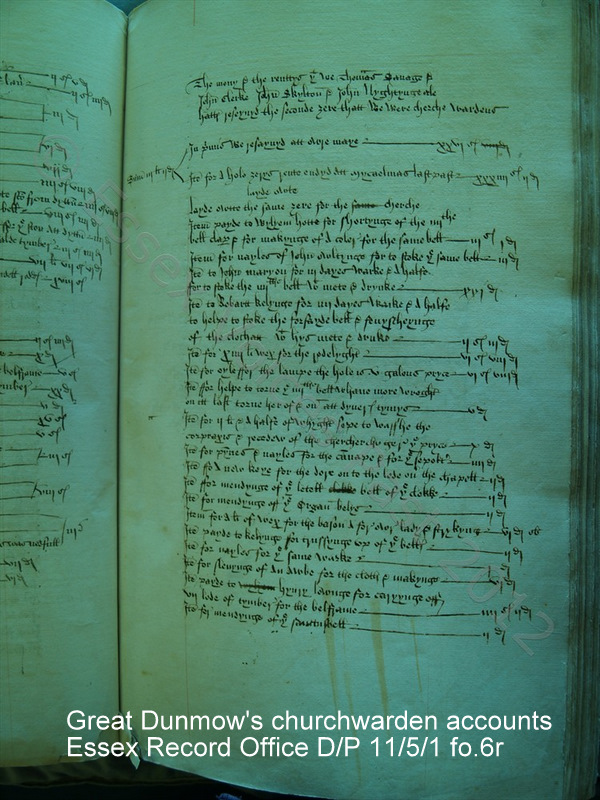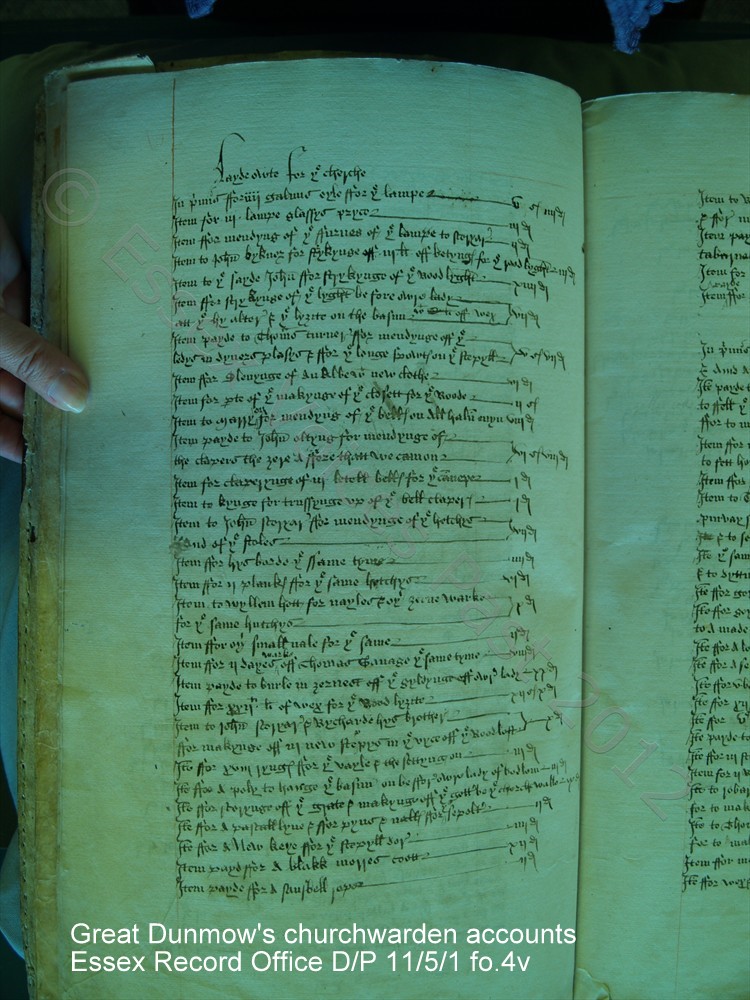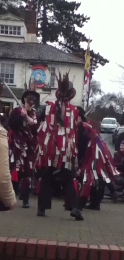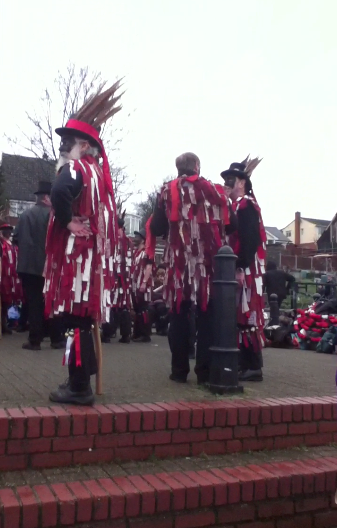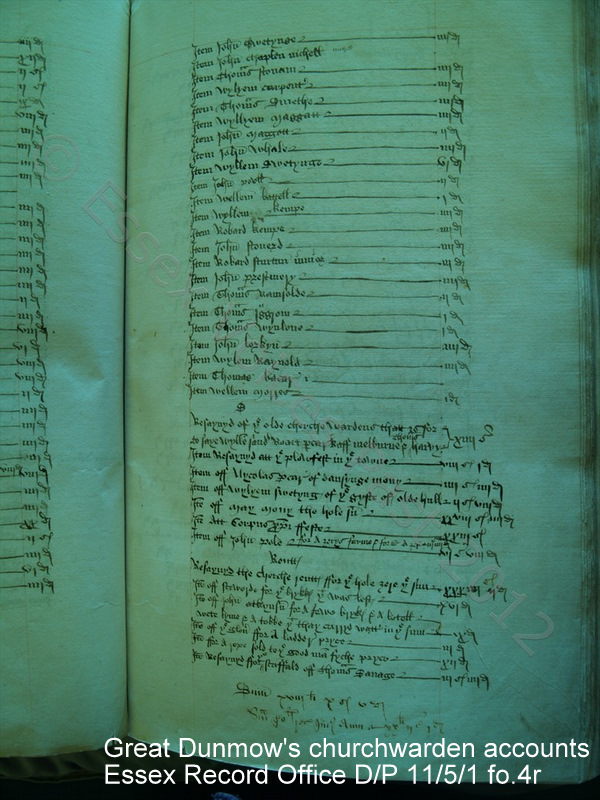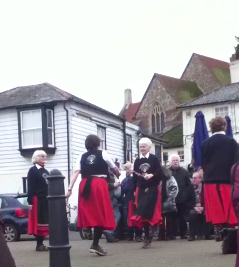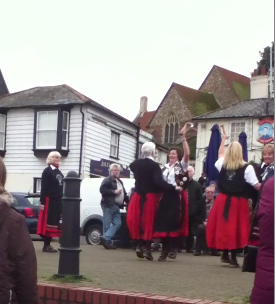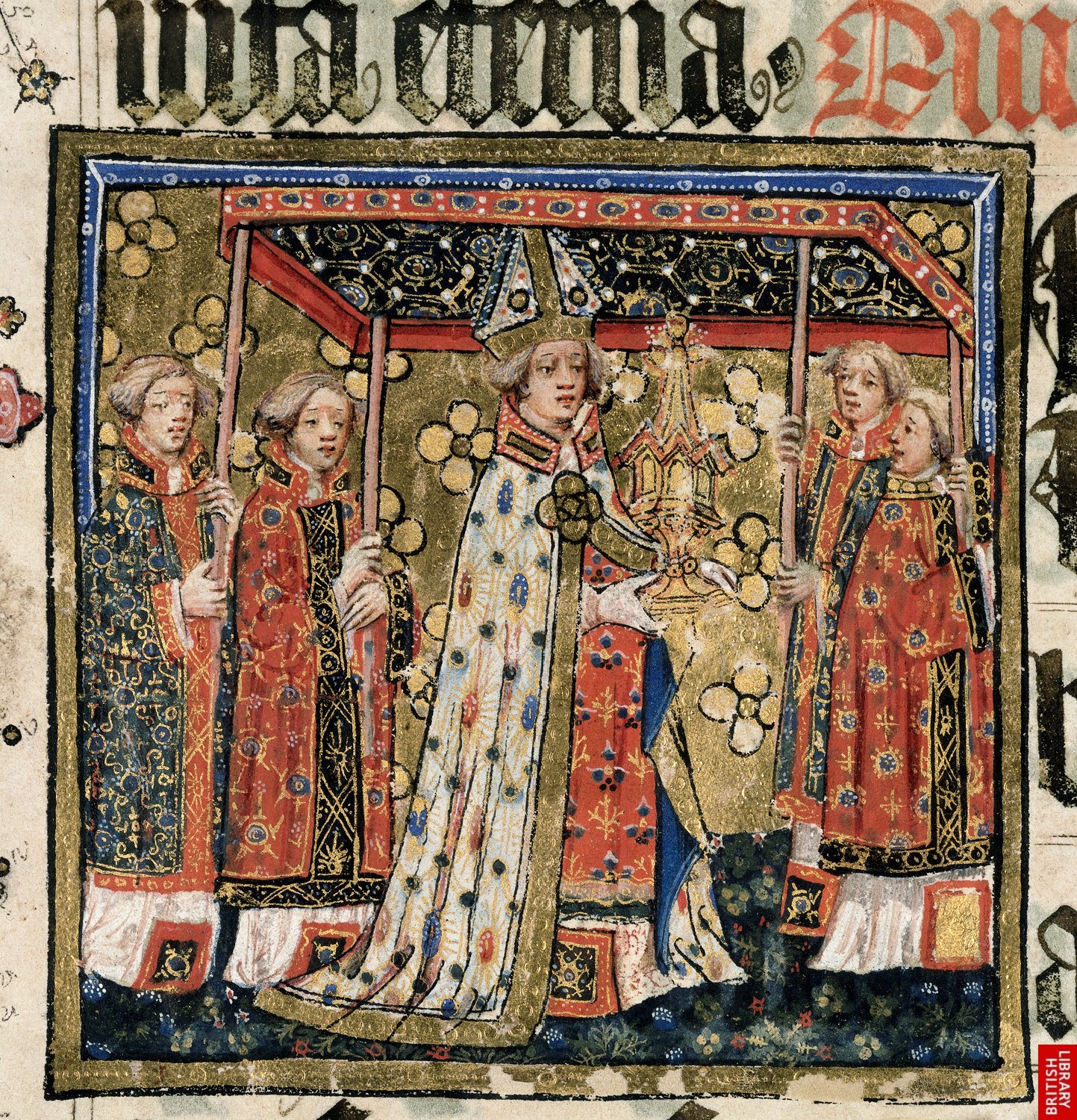Transcript fo. 6r: Easter celebrations in late medieval parish
Transcription of Tudor Great Dunmow’s churchwardens’ accounts (1526-7)
| 1. The mony & the renttys ych we Thomas Savage & [The money & rents which we Thomas Savave &] | ||
| 2. John clerke John skylton & john nyghtyngeale [John Clerke John Skylton & John Nightingale] | ||
| 3. hath resyvyd the seconde yere thatt we were cherche wardens [hat received the second year that we were church wardens] | xxvjs viijd | |
| [margin note] summa iij li ijd [sum £3 2d |
4. In primmis we resayvyd att owre maye [First, we received at our May] | xxxiiijs ijd |
| 5. Ite for a hole yerys rente endyd att mycaelmas last past | ||
| 6. [heading] layde owte [laid out] | ||
| 7. Layde owtte the same yere for the same cherche [Laid out the same year for the same church] | ||
| 8. Item payde to Wylyem hotte for shortynge of the iiijthe [Item paid to William Hotte for shorting of the 4th ] | ||
| 9. bell clap[er] & for makynge of a coler for the samel bell [bell clapper & for making of a collar for the same bell] | iijs id | |
| 10. Item for nayles of John owltynge for to stoke ye same bell [Item for nails of John Owlting for to stoke the same bell] | iijd | |
| 11. Ite[m] to john maryou for iij dayes warke & a halfe [Item to John Mayor for 3 and half days work] | ||
| 12. for to stoke the iiijthe bell wt mete & drynke [for to stoke the 4th bell with meat & drink] | xxid | |
| 13. Ite[m] to Robartt kelynge for iiij dayes warke & a halfe [Item to Robert Keling for 4 & a half days work] | ||
| 14. to helpe to stoke the forsayde bell & fenyscheynge [to help stoke the aforesaid bell & fetching(??)] | ||
| 15. of the clothall wt hys mete & drnke [of the clothall with his meat & drink] | ijs iiid | |
| 16. Ite[m] for xiiij li wex for the rodelyght [Item for 14 pounds wax for the rood light] | vis viijd | |
| 17. Ite[m] for oyle ffor the lampe the hole rs v galons pryce [Item for oil for the lamp the whole year(??) 5 gallons price] | vjs viijd | |
| 18. Ite[m] ffor helpe to torne ye iiijthe bell whane(??) more wreght [Item for help to turn the 4th bell one(??) more ??] | ||
| 19. on ill last torne her of & on all dyvers tymys [on ? last turn here off & on all divers times] | vd | |
| 20. Ite[m] for ij li & a half of whyght sope to wasshe the [Item for 2 & a half pounds of whight soap to wash the] | ||
| 21. corpraxis & recedew of the chercherche ger ye pryce [corpraxis & residue of the church gear the price] | xd | |
| 22. Ite[m] for pyn[n]es & nayles for the can[n]ape & for ye sepelc [Item for pins & nails for the canopy & for the sepulchre] | iiijd | |
| 23. Ite[m] ffor a new keye for the dore on the lede on the chapell [Item for a new key for the door on the led(?) on the chapel] | ijd | |
| 24. Ite[m] ffor mendynge of ye letell clokke bell of ye clokke [Item for mending of the little clock bell of the clock] | ijd | |
| 25. Ite[m] for mendynge off ye Organ belys [Item for mending of the organ’s bellows] | iid | |
| 26.Ite[m] for a li of wex for the bason a for owr lady & scrykyng [Item for a pound of wax for the basin afore Our Lady and striking(??)] | vid ob | |
| 27. Ite[m] payde to kelynge ffor trussynge up of ye bell [Item paid to Keling for trussing up of the bell] | iid | |
| 28. Ite[m] for nayles for ye same warke [Item for nails for the same work] | id | |
| 29. Ite[m] for slewynge of an awle for the cloth & makynge [Item for sewing of an awl(??) for the cloth & making] | vid | |
| 30. Ite[m] payde to wylyem hynry lownge for caryynge off [Item paid to william henry Long for carrying off] | ||
| 31. vij lode of tymber for the belframe [7 load of timber for the bellframe] | iiijs iid | |
| 32. Ite[m] for mendyng of ye scanttus bell | ijd | |
Commentary
Line 1: We are now in the next year of the churchwardens’ account i.e. 1526-7.
Line 4: The May i.e. May Day.
Line 5: Michaelmas Day is 29th September. Originally a medieval Catholic Saint’s day for St Michael, the Archangel, over time Michaelmas become one of the English legal system’s quarter days for paying landlords their rent.
Line 16: Wax for the rood light. The 14 pounds of wax detailed here is probably for the entire year. This is quite a substantial weight so the rood-light (i.e. the candle in front of the rood) must have been quite large. The rood was the cross at the entry to the chancel and often had images of the Virgin Mary on one side and St John on the other side. No evidence survives as to what Great Dunmow’s pre-Reformation rood looked like. As the church was dedicated to St Mary the Virgin, it is likely that the pre-Reformation rood also contained the images of St Mary and St John. Sadly, very few English medieval roods survived the Reformation.
Line 21: corpraxis a cloth on which the host and the chalice was placed on during Mass.
Line 26: ob [in the money column] Latin abbreviation – short for obolus. One-half old penny.
Line 32: Sanctus bell (small hand-held bells).
Easter week in late medieval Great Dunmow
Line 22: The sepulchre represented the tomb of Christ and was used (or created) in many medieval/pre-Reformation English Catholic churches during Easter week. From Good Friday until Easter Sunday, the church’s consecrated religious items were hidden in their sepulchre and a man was set to watch over the sepulchre night and day until Easter morning. During the reign of Henry VIII, in Great Dunmow’s churchwardens’ accounts, there are numerous references to pins, nails, lights and canopies for the sepulchre, along with payments to the sepulchre’s watcher. Watching over the sepulchre was a serious duty for the men of the parish as there are also references for charcoal for the fires burnt by these watchers.
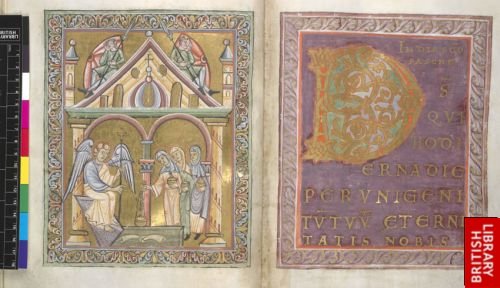 ‘Three Holy Women at the Tomb, facing the text used to celebrate Easter mass’ from the Augsburg Sacramentary (Augsburg, Germany, 2nd or 3rd quarter 11th century),
‘Three Holy Women at the Tomb, facing the text used to celebrate Easter mass’ from the Augsburg Sacramentary (Augsburg, Germany, 2nd or 3rd quarter 11th century),
shelfmark Harley 2908 fos. 53v-54, © British Library Board.
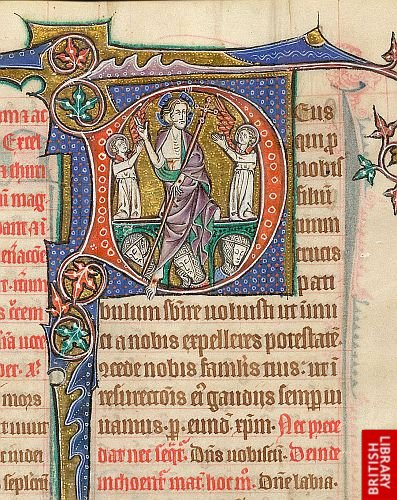 ‘Resurrection of Christ, at the beginning of Easter prayers’ from The Stowe Breviary (Norwich, England, between 1322 and 1325), shelfmark Stowe 12 f. 87,
‘Resurrection of Christ, at the beginning of Easter prayers’ from The Stowe Breviary (Norwich, England, between 1322 and 1325), shelfmark Stowe 12 f. 87,
© British Library Board.
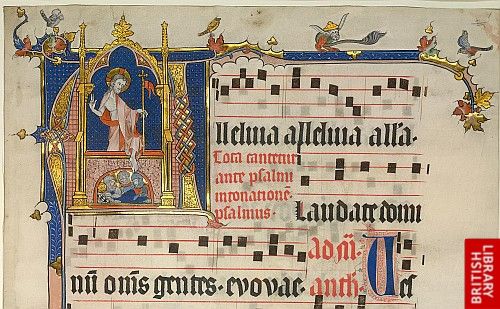 ‘Resurrection of Christ, from a liturgical text for Easter’ from A Dominican Antiphoner (North France, 1st quarter of the 14th century),
‘Resurrection of Christ, from a liturgical text for Easter’ from A Dominican Antiphoner (North France, 1st quarter of the 14th century),
shelfmark Yates Thompson 25 f. 1, © British Library Board.
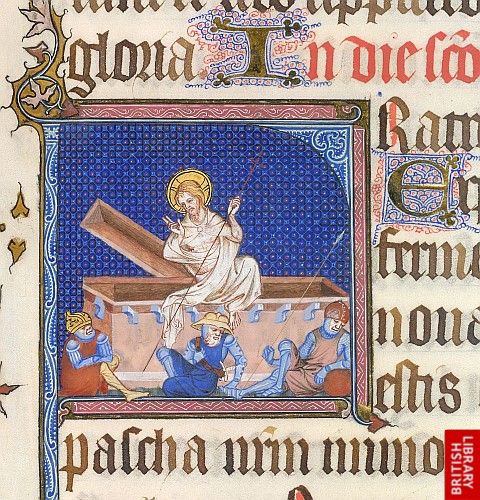 ‘Resurrection of Christ, at the reading for Easter’ from Epistolary of the Sainte-Chapelle (Paris, 2nd or 3rd quarter 14th century),
‘Resurrection of Christ, at the reading for Easter’ from Epistolary of the Sainte-Chapelle (Paris, 2nd or 3rd quarter 14th century),
shelfmark Yates Thompson 34 f. 84, © British Library Board.
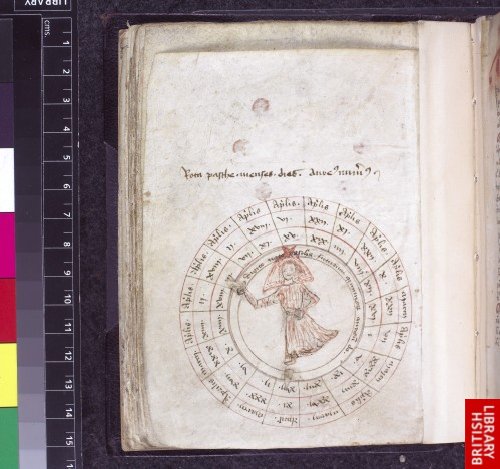 Volvelle for calculating Easter and other movable feasts (England, 2nd half of 15th century), shelfmark Harley 941 f. 29v, © British Library Board.
Volvelle for calculating Easter and other movable feasts (England, 2nd half of 15th century), shelfmark Harley 941 f. 29v, © British Library Board.
All digital images from the British Library’s Online Images archive appear by courtesy of the British Library Board and may not be reproduced (© British Library Board).
Notes about Great Dunmow’s churchwarden accounts
Great Dunmow’s original churchwardens’ accounts (1526-1621) are kept in Essex Record Office (E.R.O.), Chelmsford, Essex, D/P 11/5/1. All digital images of the accounts within this blog appear by courtesy of Essex Record Office and may not be reproduced. Examining these records from this Essex parish gives the modern reader a remarkable view into the lives and times of some of Henry VIII’s subjects and provides an interpretation into the local history of Tudor Great Dunmow.
*-*-*-*-*-*-*-*-*-*-*-*-*-*-*-*-*
This blog
If you want to read more from my blog, please do subscribe either by using the Subscribe via Email button top right of my blog, or the button at the very bottom. If you’ve enjoyed reading this post, then please do Like it with the Facebook button and/or leave a comment below.
Thank you for reading this post.
You may also be interested in the following
– Index to each folio in Great Dunmow’s churchwardens’ accounts
– Great Dunmow’s Churchwardens’ accounts: transcripts 1526-1621
– Tudor local history
– Pre-Reformation Catholic Ritual Year
© Essex Voices Past 2012-2013.
